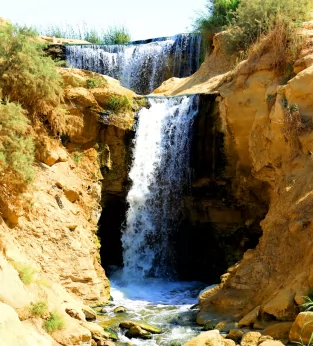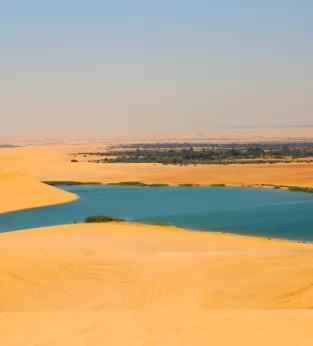Stay updated!
Embark on a journey to the mesmerizing White Desert National Park in Egypt with us, where extraordinary travel experiences await you. Our small, intimate groups and educational tours, led by expert guides, offer a unique opportunity to explore the surreal beauty of Egypt's White Desert region like never before.
The White Desert in Egypt is renowned for its stunning geological formations, including whimsical shapes like mushrooms, ice cream cones, a tent, and even a spaceship. As you traverse through this remarkable landscape, you will witness the intricate beauty of the local snow-white chalk outliers that create a truly otherworldly atmosphere. Each formation in the Black and White Desert tells a story, inviting you to interpret its shapes and contours in your own way.
With Inside Egypt's exclusive guided tours, you will have the privilege of delving deep into the heart of the White Desert of Egypt, discovering hidden gems and witnessing the natural wonders that have captivated travelers for generations.
Our knowledgeable guides will provide insightful commentary, unveiling the secrets of this unique desert landscape and enhancing your understanding of its geological significance.
After a day of exploration, retreat to comfortable accommodations nestled amidst the serene beauty of the desert. Immerse yourself in the tranquility of the desert night sky, dotted with twinkling stars that illuminate the vast expanse of the White Desert. Experience the ultimate blend of adventure and relaxation as you indulge in the comfort of our carefully selected accommodations, designed to offer you a peaceful respite in the heart of this enchanting landscape.
Join us at Inside Egypt for an unforgettable tour through the White Desert, where every moment promises a new discovery, a deeper connection with nature, and a truly immersive travel experience. Let us guide you through this extraordinary landscape, where the allure of the desert's unique landscapes and geological formations will leave you in awe of the natural world's magnificence.
Let your adventure in Egypt begin! Book your Luxury Egypt Private Tour!
Photos of the White Desert
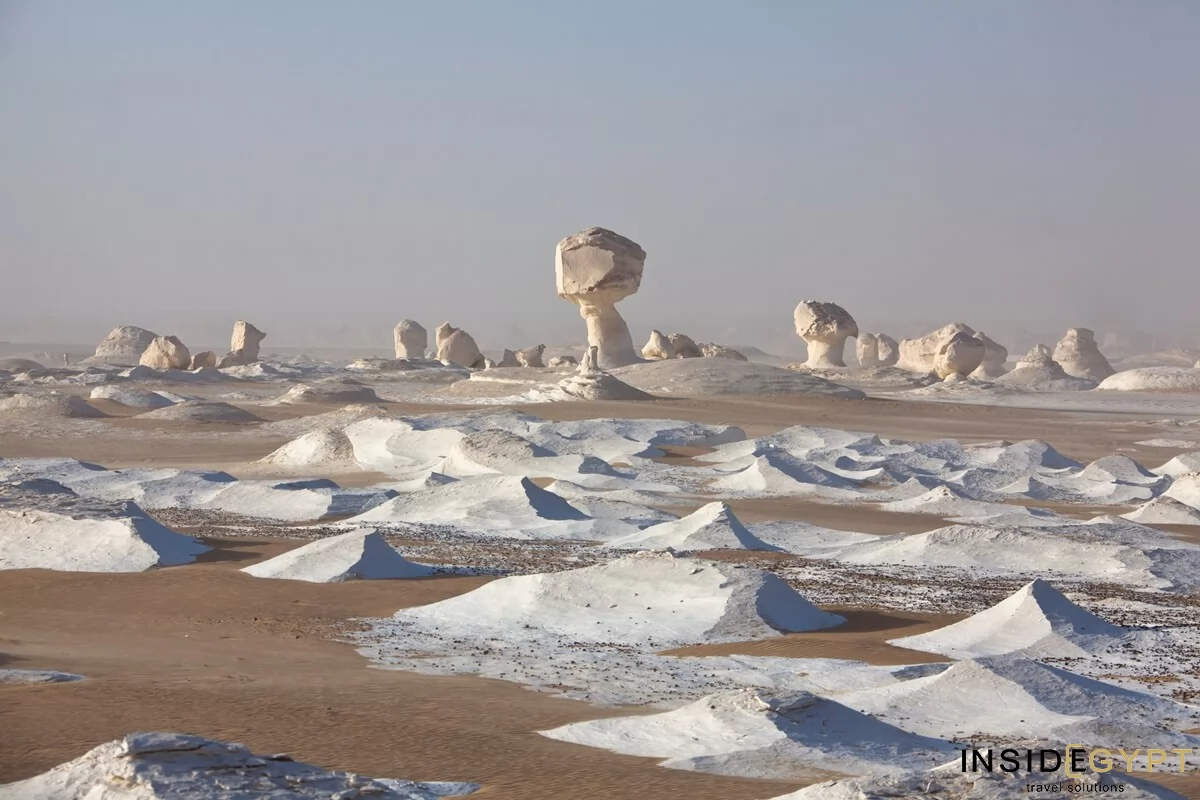
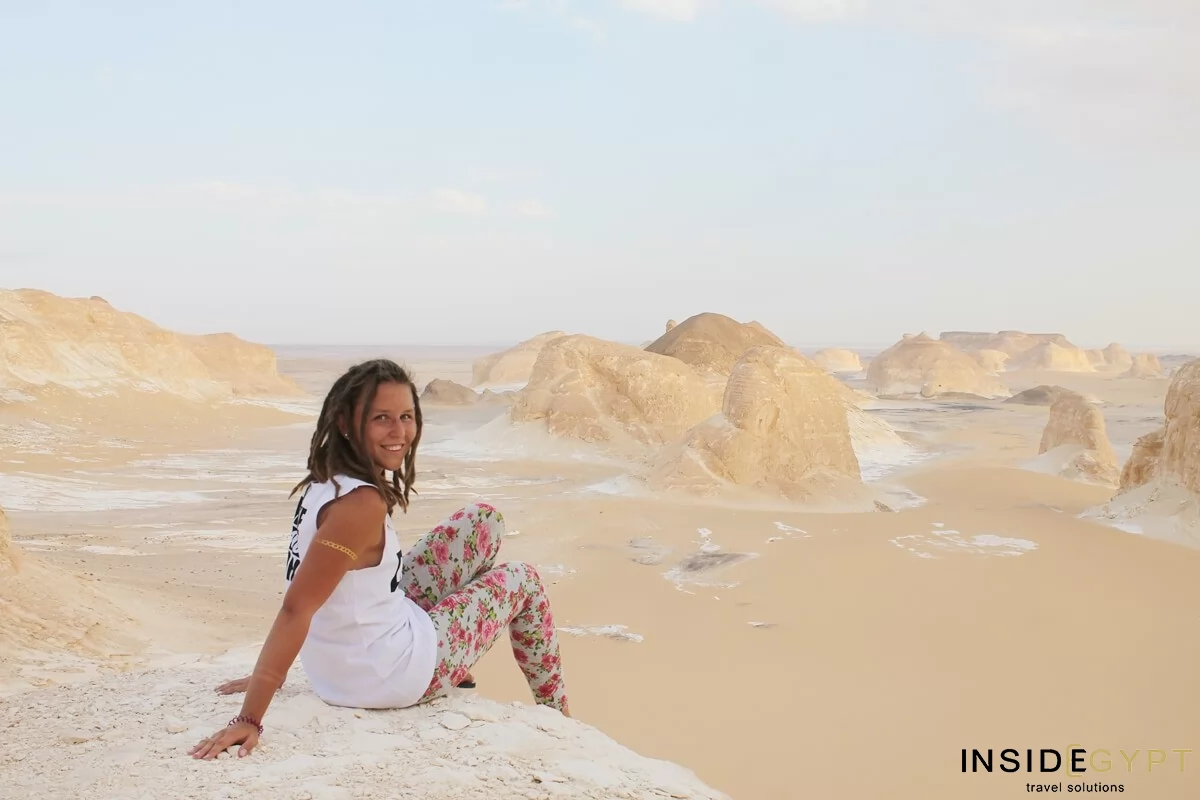
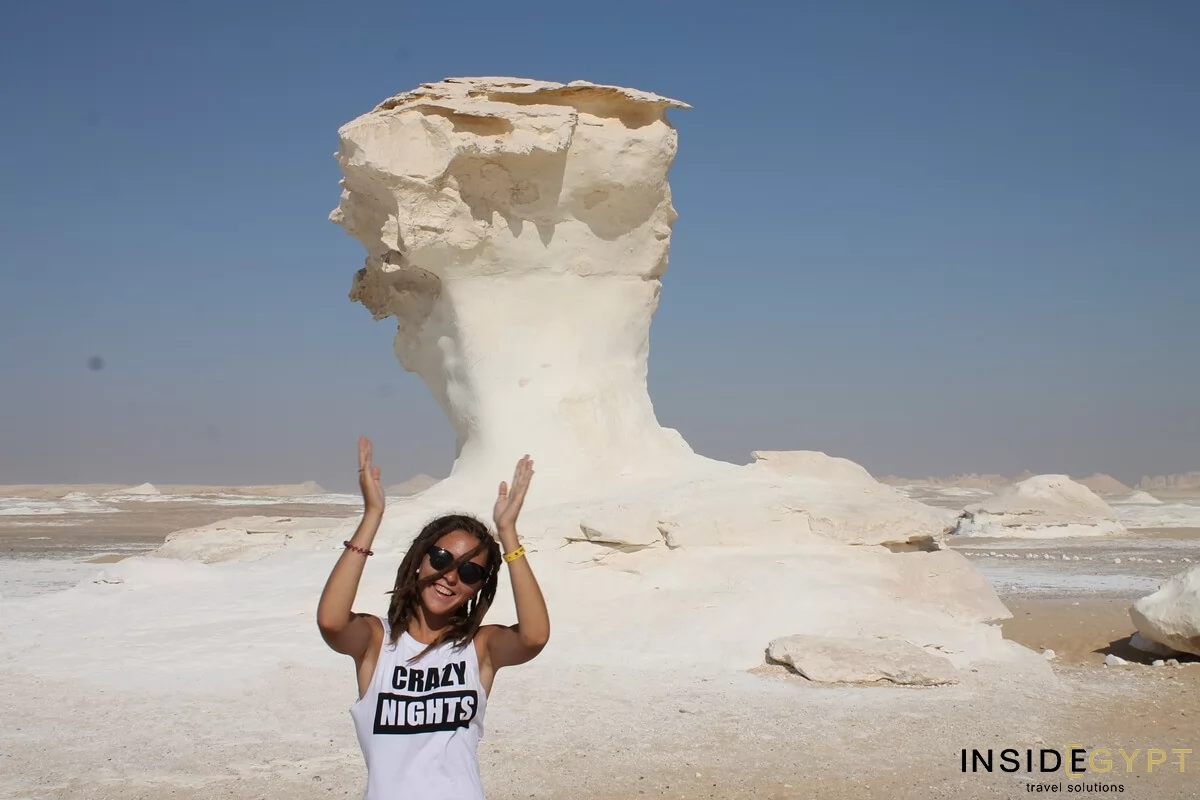
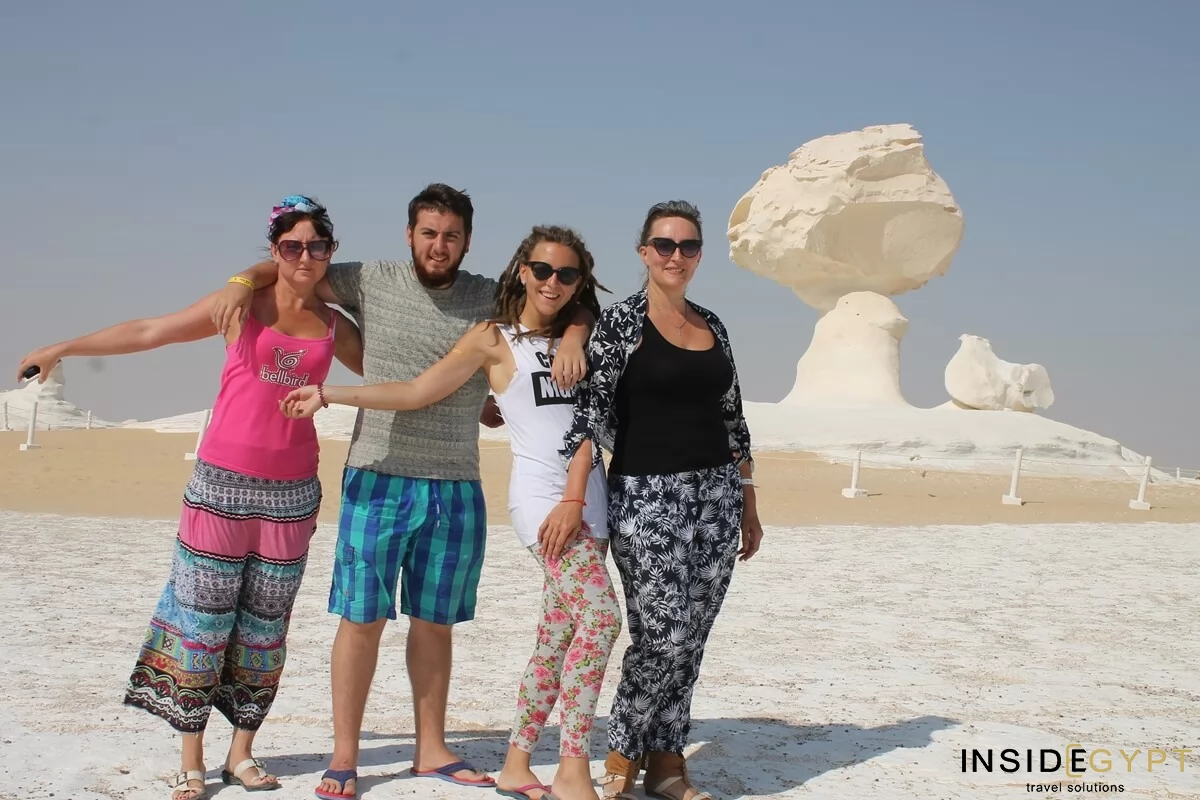



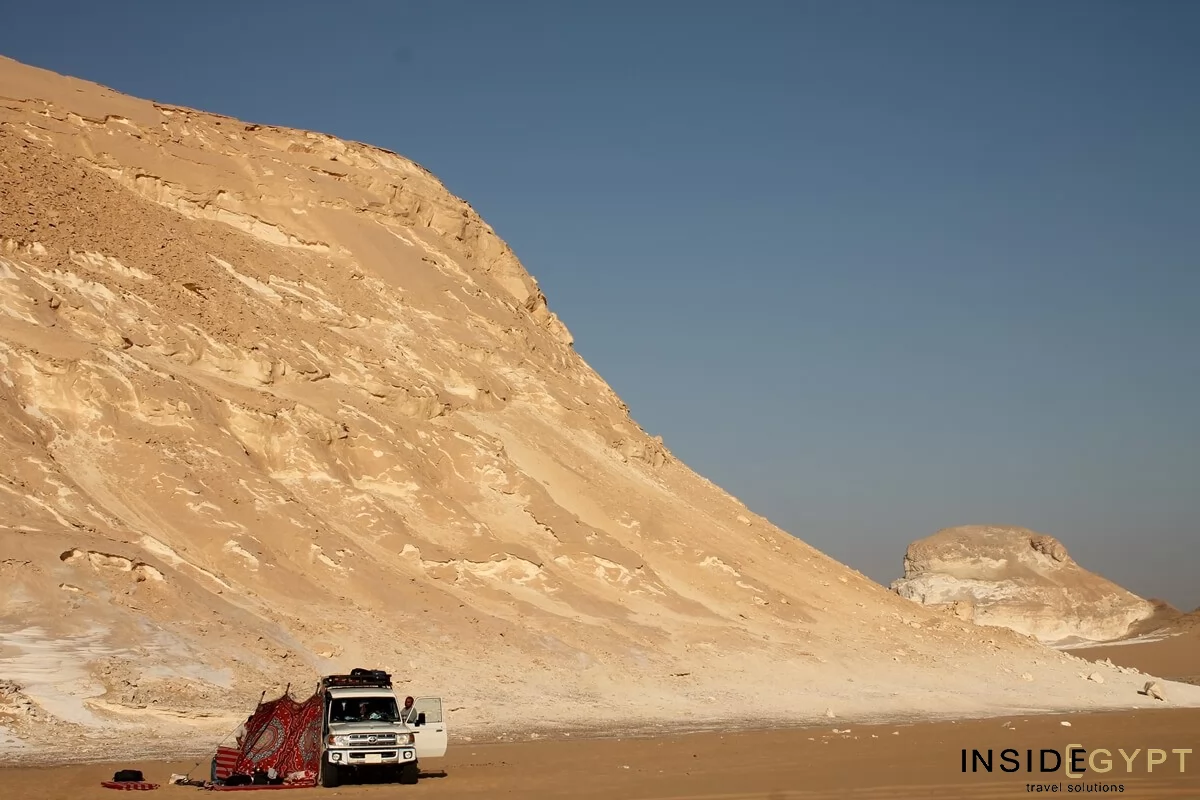

Discover Our Exclusive Egypt Tours
Tour Reviews
FAQs About the White Desert in Egypt
What is the White Desert famous for?
The White Desert in Egypt is a natural wonder that stands out for its distinctive white chalk rock formations and other geological marvels, making it an iconic destination that draws travelers from around the world. Located in the Farafra region of Egypt's Western Desert, the White Desert is part of the larger Sahara Desert that covers much of North Africa.
While it is often associated with vast desert landscapes, Egypt is not all desert. The Sahara Desert, including the White Desert, is a prominent feature of Egypt's geography but does not encompass the entire country. The White Desert's unique landscape sets it apart from other desert regions, offering a surreal and mesmerizing experience for visitors.
The White Desert is famous for its breathtaking white chalk rock formations, which give the desert its name and make it a unique geological wonder. These chalk rock formations have been sculpted by centuries of wind erosion, resulting in stunning shapes and structures that resemble mushrooms, ice cream cones, tents, and even spaceships. The contrast between the pristine white rocks and the golden desert sands creates a visually striking and almost otherworldly scene.
The White Desert is also known for its vast expanse of white desert sands, interspersed with black volcanic rocks that add another layer of contrast to the landscape. This diverse terrain, with its mix of chalk formations, sand dunes, and volcanic rocks, creates a dynamic and visually captivating environment, unlike any other in the world.
Visitors to the White Desert can witness the surreal beauty of this natural wonder, exploring its unique geological formations and marveling at the intricate shapes and textures created by the forces of nature. Whether camping under the starlit sky, hiking through the sculpted rock formations, or simply taking in the breathtaking views, a journey to the White Desert promises an unforgettable experience that showcases the awe-inspiring wonders of Egypt's desert landscapes.
Where is the White Desert National Park located?
The White Desert National Park is located in Egypt, specifically in the Farafra depression, which lies approximately 45 kilometers north of the town of Qasr Al Farafra. It is situated in the Farafra Oasis within the New Valley Governorate.
Accessibility to the White Desert National Park has improved over the years, which allows more visitors to experience its surreal beauty. Travelers can reach the park by various means of transportation from Cairo, the capital of Egypt. The most common way to get to the White Desert is by driving or taking a tour bus. The journey from Cairo to Farafra Oasis can take around 5 to 6 hours by car, depending on traffic and road conditions. Another option is to travel by bus, which usually takes longer but is a more budget-friendly choice.
In terms of proximity to other notable landmarks in Egypt, the White Desert National Park is relatively close to the Bahariya Oasis, another picturesque desert oasis known for its hot springs and archaeological sites. From the White Desert, visitors can also explore the Crystal Mountain, a crystal formation nestled in the Western Desert of Egypt. The park's location makes it a part of a larger network of natural wonders and historical treasures that Egypt has to offer.
The White Desert National Park in Egypt is a must-visit destination for nature enthusiasts, adventure seekers, and anyone looking to witness a landscape unlike any other. The remote yet accessible location of the White Desert, and proximity to other significant landmarks make it a valuable addition to Egypt's rich array of tourist attractions.
How was the White Desert of Egypt formed?
The unique landscape of the White Desert in Egypt was formed primarily through the forces of erosion and sedimentation over millions of years. The area was once covered by an ancient sea, and as the sea dried up, it left behind layers of marine sediment. Like other white deserts across the world, over time, wind and water erosion sculpted the layers of sedimentary rock into the stunning rock formations and white chalk rock formations that we see today.
The wind, carrying abrasive sand particles, played a significant role in shaping the landscape. Through a process known as ventifacting, the sand particles acted as natural sandblasting agents, smoothing and shaping the rocks into intricate formations. This constant erosion by wind and occasional water flow gradually carved out the unique shapes and contours that define the otherworldly beauty of the White Desert.
The region's geological composition, including various types of sedimentary rocks like limestone and chalk, also played a crucial role in the formation of the distinctive white landscape. The combination of these geological processes has resulted in the creation of the mesmerizing and surreal terrain of the White Desert of Egypt that attracts visitors from around the world.
What is there to do in the White Desert?
The White Desert offers a range of activities and attractions so that visitors can enjoy its unique and ethereal landscape. Here are some popular things to do in the White Desert:
Exploring Rock Formations: One of the main attractions of the White Desert is its stunning rock formations, sculpted by wind and sand over centuries. Visitors can wander through the desert and marvel at the various shapes and sizes of the chalk rock formations, some of which resemble mushrooms, animals, and other intriguing figures.
Hiking and Trekking: The White Desert provides an excellent setting for hiking and trekking enthusiasts. Exploring the desert on foot allows visitors to immerse themselves in the serene atmosphere and appreciate the natural beauty of the landscape up close.
Camping Under the Stars: The White Desert is renowned for its clear skies, making it an ideal location for stargazing. Visitors camp overnight in the desert and witness the breathtaking night sky filled with countless stars, creating a magical and unforgettable experience. *Please note that camping in the desert is not currently possible.
Sandboarding and Dune Bashing: Adventurous travelers can engage in sandboarding, a thrilling activity where you glide down the sandy slopes on a board. Dune bashing, on the other hand, involves driving over sand dunes in a 4x4 vehicle for an exhilarating off-road adventure.
Photography: The White Desert's surreal and otherworldly landscape provides endless opportunities for photography enthusiasts to capture its beauty. The unique rock formations, stark white sands, and changing light throughout the day are a photographer's dream.
By engaging in these activities and exploring the natural wonders of the White Desert, visitors can fully appreciate the mesmerizing beauty and tranquility of this extraordinary destination in Egypt.
What kind of accommodation is in the White Desert?
In Egypt's White Desert, accommodation options are primarily centered around the Farafra Oasis area. While camping in the desert may not be currently possible, visitors can still enjoy unique lodging experiences in atmospheric hotels located in the Farafra Oasis. These hotels are not luxurious, but they offer a unique charm that reflects the desert and oasis surroundings.
Some of the accommodation options in the White Desert area include:
Desert Lodges: These lodges provide a cozy and authentic experience, often designed to blend with the desert environment. They offer basic amenities in a rustic setting, allowing guests to immerse themselves in the tranquility of the desert.
Eco-Friendly Accommodations: Some lodging options in Egypt's White Desert focus on eco-friendly practices, incorporating sustainable elements into their design and operations. This provides visitors with a chance to have a more environmentally conscious stay while enjoying the natural beauty of the surroundings.
Guesthouses and Boutique Hotels: In the Farafra Oasis, there are guesthouses and boutique hotels that offer comfortable stays with a touch of local hospitality. These accommodations provide a cozy retreat after a day of exploring the White Desert's mesmerizing landscapes.
By choosing these atmospheric accommodations in the Farafra Oasis, visitors can enjoy a different kind of lodging experience that complements the desert and oasis setting, adding to the overall adventure and charm of their stay in the White Desert National Park.
Is the White Desert a part of the Sahara?
The White Desert, also known as the "Sahara el Beyda" in Arabic, is a unique desert region located in Egypt's Western Desert. While Egypt is often associated with vast expanses of desert landscapes and people often believe it’s pure desert, it's essential to note that not all of it is like this. The Sahara Desert itself is a massive desert that spans several countries in North Africa, including Egypt, but does not cover all of Egypt.
In Egypt, the Western Desert is home to various desert landscapes, including the White Desert and the Black Desert, which are distinct regions within this vast arid expanse. The White Desert in Egypt is renowned for its surreal white chalk rock formations, created by millions of years of geological processes like wind and water erosion. In contrast, the Black Desert, located nearby, features dark volcanic rock formations that contrast starkly with the surrounding desert terrain.
Despite Egypt's association with the Sahara Desert due to its proximity and shared desert landscapes, the White Desert itself is not considered a part of the Sahara Desert proper. The Sahara Desert extends across multiple countries in North Africa, such as Algeria, Chad, Egypt, Libya, Mali, Mauritania, Morocco, Niger, Western Sahara, Sudan, and Tunisia, but the White Desert is a distinct region within Egypt's desert landscape.
While Egypt does feature various desert regions like the White Desert and the Sahara Desert, it is not entirely covered by deserts. The country also boasts fertile Nile River valleys, lush oases like the Farafra Oasis near the White Desert, and diverse landscapes beyond the arid deserts.
Though the White Desert is a captivating desert region in Egypt's Western Desert, it is not directly part of the Sahara Desert but rather a unique geological formation within Egypt's broader desert landscape.
When is the best time to visit the White Desert?
The best time to visit the White Desert in Egypt is typically during the cooler months, which fall between the late autumn and early spring. The optimal time to explore the White Desert National Park and enjoy its unique landscapes is from October to April. During this period, the weather is more pleasant, with milder temperatures making outdoor activities more comfortable.
In the months of October to April, daytime temperatures in the White Desert National Park range from around 20°C to 30°C (68°F to 86°F), making it ideal for hiking, camping, and exploring the desert without the scorching heat of the summer months. The evenings can get cooler, especially in the winter months, so it's advisable to bring layers to stay warm during the night.
Visiting during these months also allows you to avoid the extreme heat that the region experiences during the summer, where temperatures can soar well above 40°C (104°F), making outdoor activities challenging and uncomfortable.
Overall, the period between October and April offers the most favorable weather conditions, optimal travel periods, and a more pleasant overall experience for visitors looking to discover the enchanting beauty of the White Desert in Egypt.
Is there a Black Desert along with the White Desert?
There is a Black Desert located near the White Desert in Egypt's Western Desert region. The Black Desert is a distinctive area known for its dark volcanic rock formations that create a stark contrast to the white chalk rock formations of the nearby White Desert.
Situated not far from the town of Bahariya Oasis, the Black Desert gets its name from the blackened basalt rocks and volcanic hills that scatter the landscape, giving it a dramatic and otherworldly appearance. Unlike the white formations of the White Desert, the Black Desert's dark rocks were formed by ancient volcanic activity, creating a unique geological setting that stands out against the surrounding desert terrain.
The Black Desert's rugged and dark landscape offers a striking contrast to the bright white sands of the nearby White Desert, providing visitors with a diverse and visually captivating desert experience. Exploring the Black Desert allows travelers to witness the natural beauty of the volcanic rocks, sand dunes, and valleys that make up this unique desert region.
While the White Desert in Egypt attracts visitors with its surreal white rock formations shaped by wind and erosion, the Black Desert offers a different but equally mesmerizing setting with its dark, volcanic features. Together, these two desert regions in close proximity to each other create a fascinating juxtaposition of colors and geological formations, making them popular destinations for travelers looking to explore the diverse and captivating landscapes of Egypt's Western Desert.
What People Have to Say About the White Desert
Below are some testimonials from our clients who have had an opportunity to embark on private tours to the breathtaking White Desert in Egypt. We believe that the best way to understand the beauty and wonder of the White Desert is through the voices of those who have experienced it firsthand. We invite you to read these testimonials and discover what makes the White Desert a must-visit location for any traveler seeking a unique and enchanting experience in Egypt.
"I visited the White and Black Deserts in Egypt in December 2023, and I definitely recommend it. It's a place unlike any other, offering a total lack of crowds in those parts of Egypt and showcasing stunning landscapes. The trip was very well organized; the price included private transportation to the Bahariya Oasis from Cairo in both directions, followed by a further journey in 4x4 vehicles. I recommend it to everyone!" Donald Charron
"The White Desert is truly one of the most breathtaking natural wonders I have ever had the privilege to visit. Its vast, otherworldly landscape is unlike anything else, with stunning white chalk formations that have been sculpted by the wind over time. The beauty of this place is especially pronounced during the early morning hours, when the soft glow of dawn begins to illuminate the unique rock formations. However, the experience becomes even more magical if you can spend the night underneath the stars. The White Desert is undeniably a highlight of my travels in Egypt." Kimberley Willick
Discover Our Exclusive Egypt Tours
Discover luxury with Inside Egypt's exclusive tour packages. Unveil unique experiences and premium services crafted to enhance your journey through captivating destinations. Choose from our extraordinary selection for a travel experience redefined.
17 Days in Egypt on a Long Nile Cruise: Luxury Nile cruises, iconic sites like the Great Pyramid, Sphinx, remote wonders, and majestic temples await you on this unforgettable journey through Egypt. Engage in interactive sessions to deepen your understanding of Egypt's history and culture.
15-Day Egypt Tour with Siwa Oasis: Experience opulence, discovery, and cultural immersion on this 15-day tour through hidden treasures in Egypt. From Siwa Oasis to Luxor and Aswan, uncover ancient wonders and relax on a luxurious Nile cruise.
14 Days in Egypt Tour: Explore captivating landscapes and rich history on this luxury tour. Enjoy exclusive access to iconic sites, a luxurious Nile cruise, and an immersive cultural experience.
12-Day Red Sea Tour: A 12-day luxury adventure from Cairo to the Red Sea. Explore Ancient Egypt's wonders, enjoy a deluxe Nile cruise, and experience the vibrant coral reefs of the Red Sea.
10-Day Tour of Egypt: Uncover Cairo, Giza, Luxor, and Aswan's wonders in this 10-day tour. Cruise the Nile, marvel at ancient pyramids, and immerse yourself in Egypt's rich culture.
8-Day Egypt Tour: An 8-day exploration through Cairo, Luxor, and Abu Simbel. Discover iconic sites, enjoy a deluxe Nile cruise, and indulge in delicious Egyptian cuisine.
7-Day Egypt Total Solar Eclipse Tour: Witness the 2027 total solar eclipse on this celestial journey through Luxor. Explore iconic sites, immerse yourself in luxury accommodations, and witness a celestial phenomenon like never before.
Other Sites Nearby
For travelers looking to extend their visit Egypt's Western Desert region, there are several additional attractions and sites near the Black and White Desert that offer unique experiences and opportunities for exploration. Here are some recommendations for nearby points of interest to consider:
Crystal Mountain: Located in the Western Desert not far from the White Desert, Crystal Mountain is a fascinating geological formation that features crystal-like structures embedded in the rocks. Visitors can marvel at the shimmering crystals and explore the surrounding area to witness the natural beauty of this unique site.
Bahariya Oasis: Close to the White Desert, Bahariya Oasis is one of Egypt's lush oases known for its date palms, hot springs, and archaeological sites. Travelers can relax in the natural hot springs, visit ancient tombs and ruins, and immerse themselves in the oasis's serene atmosphere.
Valley of the Golden Mummies: For history enthusiasts, a visit to the Valley of the Golden Mummies close to Bahariya Oasis is a must. This archaeological site is home to numerous mummies adorned with gold artifacts, providing insight into ancient Egyptian burial practices and rituals.Farafra Oasis: Situated near the White Desert, Farafra Oasis is another picturesque oasis worth exploring. Visitors can wander through date palm groves, visit the local museum, and experience the laid-back charm of this traditional oasis town.
Dakhla Oasis: Further afield but within reach of the White Desert, Dakhla Oasis offers a tranquil retreat with mud-brick villages, ancient sites, and natural hot springs. Travelers can unwind in the relaxing surroundings, discover historical relics, and appreciate the traditional lifestyle of the oasis communities.
By exploring these nearby attractions and sites, visitors can enrich their travel experience and gain a deeper understanding of the diverse landscapes, history, and culture of Egypt's Western Desert while complementing their visit to the captivating White Desert National Park.
